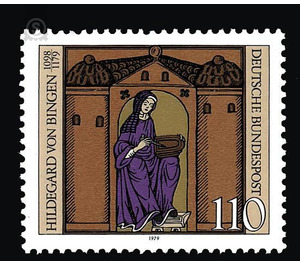800th anniversary of death of Hildegard von Bingen - Germany / Federal Republic of Germany 1979 - 110 Pfennig
Theme: Calender
| Country | Germany / Federal Republic of Germany |
| Issue Date | 1979 |
| Face Value | 110.00 |
| Color | brown |
| Perforation | K 14 |
| Printing Type | 5-color offset |
| Stamp Type | Postage stamp |
| Item Type | Stamp |
| Chronological Issue Number | 905 |
| Chronological Chapter | GER-BRD |
| SID | 88215 |
| In 35 Wishlists | |
On September 17, 1979, the Christian world commemorates the 800th anniversary of the death of Hildegard von Bingen, who went down in history as "the great woman of the Middle Ages". Her life picture and her works have survived centuries with all their turmoil and epochs in their charisma. They also have significance for our 20th century. Not only in Germany, but throughout Europe, and even to the Far East, it finds recognition and attention, which z. As evidenced by publications in Japan. For historians, physicians and theologians, the works of Hildegard von Bingen are still a treasure trove for scientific research. But especially in the Christian faith of Central Europe, people have kept the memory of this great woman who serves them as a model. The legacy of her ideas is preserved and nurtured today in the "Abbey of St. Hildegard" founded by her, Eibingen in the Rheingau. Hildegard von Bingen, born in the family of the noblemen of Bermersheim near Alzey in 1098, was handed over by her parents to the care of the Jutta von Sponheim in 1106, who lived in a hermitage at the Disibodenberg, which had recently been occupied by Benedictines. The occasion for the parents to entrust their child to the monastery was their vision. The Vita reports: "As soon as she was able to try with the first speeches, she drew her attention to certain faces, both by words and by signs, to those who were around her, in addition to the common mode of seeing of the rest of men "This connection of living contact with the realities of life and the deep-mystical vision in the last cosmic world-contexts of each individually recognized in a deep-mystical vision remained characteristic of their whole life. Familiarized in the daily Hours with the psalms and prophecies of the old covenant, she gained her unconventional prophetic style. She was quite familiar with the Latin language and her rich vocabulary. Only for the flawless grammatical form did she use her own secretaries for the written fixation of her works. After the death of Jutta in 1136 elected Master of the Hermitage, she was urged in 1138 by her face to write down what she had heard and seen. The beginnings of the book "Sci vias" (= Know the ways) were 1148 Pope Eugen III. submitted in Trier and approved by this. In the same year she moved with 20 sisters from Disibodenberg to Rupertsberg near Bingen am Rhein. Her most important work »Sci vias« combines the dogmatic truths that have been observed with warnings about God-fearing life. Between 1150 and 1158 she wrote the books "Physica" (Deed of Nature), "De Operatione Dei" (= World and Man), most of her letters and her 70 Latin sacred songs with their melodies, 58 homilies with Allegric scripture interpretation. In 1163 she finished the work "Liber vitae meritorum" (= The Book of Living Merit: Man in Charge), 1170 "Liber divinorum operum" (= world and man), a contemplation of nature in the light of faith, which derives everything from God and everything back to God, "Causae et curae" (= medicine). In the fight against the heresies of the Cathars, she conducted extended sermon journeys to Mainz, Würzburg and Bamberg, to Trier and Metz, to Bonn, Cologne and Werden. Hildegard, who lived in the mystical union with God, the cause and goal of all existence, was also the first writing doctor and the founder of scientific natural history in Germany. She died on September 17, 1179 on the Rupertsberg near Bingen am Rhein. (Text: City Administration Bingen / Rhine)


